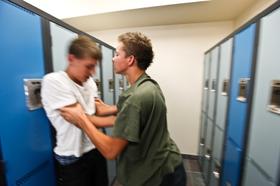Children can be cruel, and it is not uncommon for grade school students to come home in tears after someone calls them names on the bus ride home. Unfortunately, many parents do not understand the potentially damaging effects of bullying not only on a child’s confidence and self-esteem but also on his academic performance.
Shocking Statistics About Bullying
According to StopBullying.gov, a website managed by the U.S. Department of Health & Human Services, nearly 50% of students in grades 4 through 12 experienced bullying within a given month, and more than 70% of students admit to having seen bullying occur in their school. Verbal and social bullying are the two most common types, including things like name-calling, teasing, spreading rumors, stealing belongings, sexual comments and gestures, or physical violence. Physical bullying happens less often than social bullying, and cyberbullying, though it is becoming increasingly prevalent, is still less common.
While many people assume that a little bit of bullying is harmless – it may even be helpful for the child to teach them how to stick up for themselves. In reality, however, an estimated 160,000 children miss school on any given day due to fear of bullying by other students. Every day, more than 280,000 students are physically attacked in schools, and one out of ten students who drop out of school mentions repeated bullying as a factor. Bullying can have a serious impact on a child’s educational experience, and not just by causing him or her to miss school. There is a great deal of evidence to suggest that bullying hurts a child’s academic performance.
Results of a UCLA Case Study
In 2010, the results of a UCLA study were published in the Journal of Early Adolescence. This study involved 2,300 middle school students and their teachers in eleven different Los Angeles public schools. The students themselves were asked to rank the amount they were bullied on a four-point scale and to make note of which students in their classes were bullied the most. The teachers were asked to rate their students' engagement and academic performance. After collecting data over the course of three years, the results were studied and published in 2010.
According to this UCLA study, Jaana Juvonen, a professor of psychology at UCLA and lead author of the study, bullying, and low academic achievement are frequently linked. Juvonen is quoted saying, “students who are repeatedly bullied receive poorer grades and participate less in class discussions… students may get mislabeled as low achievers because they do not want to speak up in class for fear of getting bullied”. Juvenon also remarked that “Once students get labeled as ‘dumb,’ they get picked on and perform even worse.”
Following this line of thinking, it is easy to see how this cycle might become self-perpetuating. Students who are bullied show less academic improvement due to a fear of standing out. As a result, teachers often identify those students as low achievers or unmotivated learners. These students may then receive less attention from teachers which only pushes them further down the academic rankings in their school. After reviewing the study results, Juvenon suggests that the best way to reduce bullying is to provide academic support for low-performing students.
The Impact on Students and Bullies
According to the Michigan Association of School Administrators, the effects of bullying extend far beyond the academic scope. Students who are repeatedly bullied may experience physical symptoms like stomach pains, headaches, and trouble sleeping. These side effects may pair with anxiety about going to school or participating in class which only leads to further loss of interest and reduced academic performance. Students who are bullied often exhibit low self-confidence, frequently experiencing depression, suicidal thoughts, and even violent outbreaks
You may be surprised that students who bully other students also experience some negative side effects. For example, research suggests that students who bully are more likely to engage in violent behavior, steal or vandalize property, smoke, drink, report poor grades, and carry a gun. The results of multiple long-term research studies suggest that these students are also more likely to commit serious crimes later in life. Unfortunately, it is not always easy to spot a bully. Bullies can be some of the students with the highest social skills or the best grades – they may even be good at ingratiating themselves with administrators, teachers, and other adults. When it is difficult to identify the bully, it is difficult for the school to take action.
What Can Schools Do to Reduce Bullying?
Once bullying becomes a problem in a school, it can be difficult to eradicate – in fact, you may never entirely get rid of it. However, educators and parents can take certain steps to minimize bullying in their schools. The first step in reducing bullying is to increase awareness by providing education about what bullying looks like. Bullying can occur at any grade level, and it is imperative that teachers and staff have a sound definition and that they can identify bullying when it occurs. The focus must be placed on the negative behaviors, not only on the students who exhibit those behaviors. Students must understand the consequences of their behaviors and why they are wrong.
Once the school has created a sound definition to identify bullying behavior, a set of rules and policies must be put in place and enforced. It must be made clear to students, teachers, and faculty that bullying behavior will not be tolerated, and there should be clear consequences for those who break the rules. Just as important as identifying and punishing bullying behavior is, it is also important that the school rewards positive behaviors. The school should strive to create a safe and healthy environment for all students by rewarding those who provide a good example of the school’s policies.
This video looks at the correlation between bullying and academic performance.
National Bullying Prevention Center
While individual schools must take a stand against bullying, it is also important that the issue gain national attention. The National Bullying Prevention Center was founded in 2006, and it is the goal of the organization to affect social change to render bullying no longer acceptable as a childhood rite of passage. This center is run by PACER, a center for children with disabilities. PACER offers several resources for teachers, parents, and students, including an online information portal, a website for teens to become involved in the anti-bullying campaign, and an educational website for elementary school students.
PACER offers online resources to help schools, parents, and students fight against bullying and sponsors National Bullying Prevention Month, which occurs in October each year. During this month, communities nationwide gather together to raise awareness of bullying prevention, hold community events, and offer educational opportunities. The year 2016 will mark the 10-year anniversary of National Bullying Prevention Month, and several special events are being planned, including Unity Day, community walks/runs against bullying, and several educational activities for schools, parents, and students of all ages across the nation.
This video explains the work of The National Bullying Prevention Center.
Putting an end to bullying is not something that can happen overnight, and it isn’t something that can be achieved through the work of a single individual. To end bullying, teachers and parents must unite with students to create a culture of tolerance and acceptance in their schools. Only when students learn to respect and accept each other will bullying be reduced.
Questions? Contact us on Facebook and Instagram. @publicschoolreview.
#BullyingImpact #AcademicSuccess #SchoolSafety #StudentWellbeing #EducationAwareness














